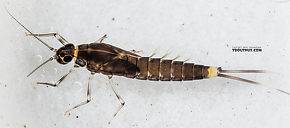Blog & Latest Updates
Fly Fishing Articles
Insects by Common Name


Dark Brown Duns
Like most common names, "Dark Brown Dun" can refer to more than one taxon. They're previewed below, along with 1 specimen. For more detail click through to the scientific names.
Mayfly Species Ameletus cooki
These are sometimes called Dark Brown Duns.
Mayfly Species Diphetor hageni
These are very rarely called Dark Brown Duns.
This is one of the most important species of the Baetidae family. Previously known as Baetis parvus in the West and its synonym (Synonym: A former name of a taxon, usually a species. Entomologists frequently discover that two insects originally described as different species are one in the same, and they drop one of the names. The dropped name is said to be a synonym of the remaining name. These changes take a while to trickle into the common knowledge of anglers; for example, Baetis vagans is now a synonym of Baetis tricaudatus.) Baetis devinctus in the East, it is distributed across the country but most of its fame comes from excellent hatches in the West. Prior to all the species being combined with Baetis tricaudatus, most angling literature considered it the most populous and widespread western species of the Baetidae family.
Dorsal (Dorsal: Top.) abdominal markings on the nymphs used to differentiate the species in these older works have since proved unreliable. The easiest way to tell them apart from B. tricaudatus is their lack of gills on the first abdominal segment. Telling adults apart is equally tough. Duns of D. hageni are typically a little smaller, but their bodies can also be olive, brownish olive and even two toned with thoraxes a shade of brown or tan with paler olivacious abdomens.
Diphetor hageni has two former names used in angling literature, Baetis parvus in the West and Baetis divinctus in the East.
Dorsal (Dorsal: Top.) abdominal markings on the nymphs used to differentiate the species in these older works have since proved unreliable. The easiest way to tell them apart from B. tricaudatus is their lack of gills on the first abdominal segment. Telling adults apart is equally tough. Duns of D. hageni are typically a little smaller, but their bodies can also be olive, brownish olive and even two toned with thoraxes a shade of brown or tan with paler olivacious abdomens.
Diphetor hageni has two former names used in angling literature, Baetis parvus in the West and Baetis divinctus in the East.
Top 10 Fly Hatches
Top Gift Shop Designs
Eat mayflies.
Top Insect Specimens
Miscellaneous Sites
Troutnut.com is copyright © 2004-2024 Jason
Neuswanger (email Jason). See my FAQ for information about use of my images.
 privacy policy
privacy policy

